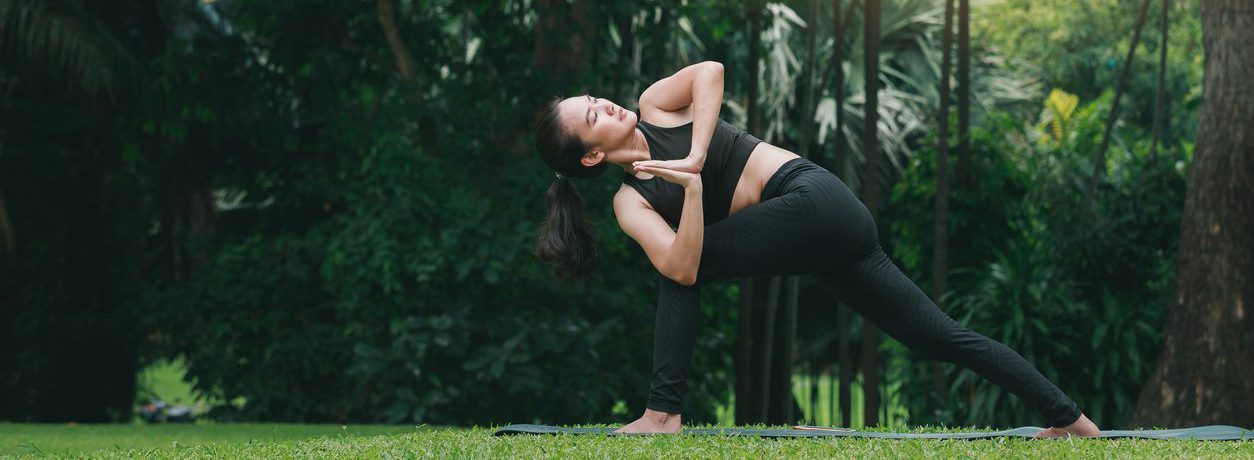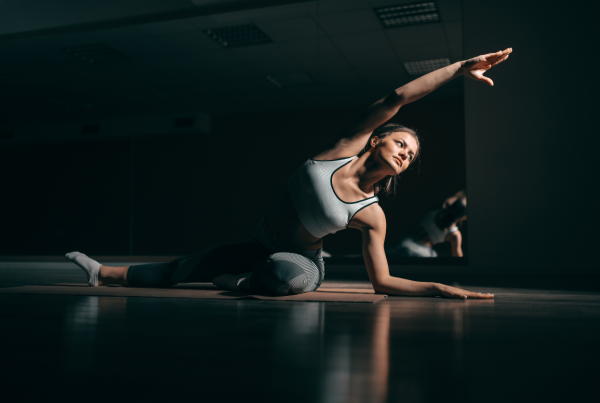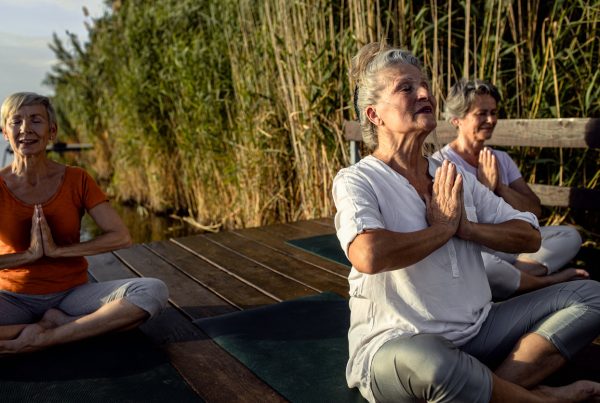Gillian Reeves looks at how a range of yoga methods could meet the needs of your clients and asks, is yoga a simple regeneration activity or is there more to it?
When programming fitness using an holistic approach to support a client’s goal, fit pros are good at recommending rest and regeneration (regen) activities alongside structured exercise sessions. Yoga is often suggested on a recovery day, as are self-myofascial release (SMR) and non-structured activities such as walking and power naps.
It’s no surprise that yoga has become so popular as it can reduce stress, decrease anxiety and depression and can even improve memory1. Within the topic of yoga, there are a lot of different styles that could support the goal of regen, recovery and rest to a greater or lesser extent.
Firstly, consider a spectrum idea. At one end, there are very active practices and, at the other, there is deep sleep. In between, there are many methods, from dynamic, sweaty styles (that may from the outside resemble a workout), to medium-paced styles, intense stretching and, finally, stillness practices.
An example of this spectrum is shown below:

This idea was presented to me in Rest & Restore training with Adelene Cheong.
With an holistic approach to programming, trainers could consider the effect of exercise and recovery sessions on the nervous system for optimum performance to support a client’s goals. At the vigorous exercise end of the spectrum, the ‘fight or flight’ or sympathetic nervous system is activated. At the deep sleep end, the ‘rest and digest’ or parasympathetic nervous system is activated2.
As a personal trainer or group exercise instructor, if you don’t know your Vinyasa from your Yin, here’s a short guide to support you in taking a first step to exploring yoga. This might help you to decide which yoga practice will best support your clients’ goals.
Gym yoga
What is it?
The focus is mainly on the physical benefits of yoga postures and modern approaches to mindfulness may be included. Some styles include Freestyle Fitness Yoga, Group Centergy, Broga and Body Balance. Traditional yoga asanas (postures) are often modified to align with fitness standards of functional movement patterns and the ethereal nature of yoga is not taught.
Who is gym yoga good for?
Due to classes being structured and sequenced with a general gym member in mind, these classes are good for people who would like to improve mobility, gain more flexibility and potentially gain flexible strength at the end ranges of their movement.
They can be a good starting point for people who are not sure about the spiritual essence of yoga but would like to explore it through a more familiar, physical point of view.
Example sequence
- From downward dog, step through to high lunge
- Lunges x 5 bending and extending front knee only
- Lunges x 5 bending and extending back knee only
- Standing spinal twist for five breaths/15 seconds
- Hand to the floor and step back to downward dog
- Repeat on the other side
Vinyasa yoga
The clue is in the Sanskrit name. Vi means ‘sequence’ and nyasa means ‘to place in a special way’. Vinyasa is a series of asanas (postures) linked together in a flowing form. The flow comes by means of breathing evenly along with the intention of the practitioner. If the goal is to experience yoga, the attainment of happiness and freedom, the intention and thoughts need to align with this3. If the goal is to get a good stretch and sweat a bit, the style is more akin to the gym yoga styles.
Ashtanga, Rocket and Jivamukti yoga methods are Vinyasa practices. The difference between these methods is the intention of the teachers who compiled and offered them, although trace the lineage of teachers back further and there is a common root in Hatha yoga.
It is good for trainers to understand that, over time, Hatha yoga classes, offered in gyms especially, have become focused on gentle stretches and alignment, and are generally less intense than described in traditional Hatha yoga books.
Who is Vinyasa yoga good for?
Clients who want a more physically demanding yoga practice, placing their bodies in a challenging but special way. Also, people looking to experience more happiness or feeling there is something more to life that could be discovered through yoga.
Example sequence
- Inhale Utkatasana, chair seat
- Exhale Uttanasana, intense forward bend seat
- Inhale Ardha uttanasana, half intense forward bend seat
- Exhale step or jump back to chaturanga dandasana, four-limbed staff seat
- Inhale Urdhva mukha svanasana, upward facing dog seat
- Exhale Adho mukha svanasana, downward facing dog seat
- Inhale Virabhadrasana 1 right side, warrior 1 seat
- Exhale Virabhadrasana 2 right side, warrior 2 seat
- Inhale plank
- Exhale Chaturanga dandasana, four-limbed staff seat
- Inhale Urdhva mukha svanasana, upward facing dog seat
- Exhale Adho mukha svanasana, downward facing dog seat
- Inhale Virabhadrasana 1 left side, warrior 1 seat
- Exhale Virabhadrasana 2 left side, warrior 2 seat
- Inhale plank
- Exhale Chaturanga dandasana, four-limbed staff seat
- Inhale Urdhva mukha svanasana, upward facing dog seat
- Exhale Adho mukha svanasana, downward facing dog seat
Does asana mean pose?
Asana translates to meaning ‘seat’. It is often referred to as a posture or pose; however, the seat implies a connection between the part of the body touching the ground, the earth. The foundation of the asana is important and the advice given on asana according to Patanjali’s <itals>Yoga Sutra</itals> (a manual or guidebook on what yoga is and how to practice it) is that it should be both steady and easeful. It makes sense that, if the foundation isn’t steady, the rest of the body won’t feel easeful.6,7
Restorative yoga
A relaxation practice of conscious, deep rest4. To switch gear and move into a rest state takes time and postures are held from between five to 30 minutes. That means that, in a 90-minute practice, there are just three or four asanas and the last one will always be a variation of Savasana (corpse seat).
There is no physical stretching sensation in a restorative asana and the use of props supports the body to be completely still. Quiescence is important, so classes don’t use music and the practitioner should feel warm as body temperature drops whilst in a resting state. Light is minimised so that the practice space is dark. These factors all support stimulating the parasympathetic nervous system, reducing blood pressure and heart rate and influencing the limbic system in the brain where emotions are processed.
Yoga Nidra (yoga sleep) and meditation practices are in a similar realm to restorative yoga, where a state of being between waking and deep sleep can be experienced to support mental and emotional equanimity.
Yin yoga is very different from restorative, although it is towards the same end of the spectrum. It focuses on deep stretching and has its roots in Taoist yoga (unlike Hatha Vinyasa, which has roots in India).
Who is restorative yoga beneficial for?
It’s suitable for so many people and is especially beneficial for people looking to manage stress and improve balance of the nervous system.5
Example posture: Salamba savasana (supported savasana)
Use a yoga bolster or a firm cushion that is as long as the torso. Place this at a 45⁰ angle leaning on some yoga bricks to hold it in position. Place a blanket to use as a head pillow at the top end of the bolster. Use another bolster, cushions or a large rolled-up blanket to put under the knees. Roll up a blanket to put under the curve of the ankles to offer a feeling of the feet floating. Arms can rest down with hands on the floor. Use an eye pillow, distributing the weight of it over the bones of the eyes rather than pressing on the eyelids. Ensure physical comfort and try to stay in the posture for 20-30 minutes.
So, is yoga as simple as a regen activity? Ultimately, yoga stems from ancient practices for realising one’s true potential and it is important to honour and respect the cultures it is associated with. Some of the more traditional practices are still popular today. You may have classes in the yoga studio down the street from the gym that offer breathing classes, chanting practices and scripture study, for example.
Allow clients to explore the yoga world. They may find many more methods, such as Iyengar, Kundalini and Anusara, that might ‘speak to’ them depending on what they are looking for.
You can view our yoga liability insurance here
Other blogs that might be of interest… Yoga and digestive health by Ann-See Yeoh and Why do sun salutations? by Jayne Nicholls.
Author Bio:
 Gillian Reeves has worked in the fitness industry for over 20 years. Former Head of Group Exercise for Virgin Active UK, former Head of Instructor Development at EMD UK, national governing body for group exercise and currently consultant and studio owner of Croydon Yoga Hub.
Gillian Reeves has worked in the fitness industry for over 20 years. Former Head of Group Exercise for Virgin Active UK, former Head of Instructor Development at EMD UK, national governing body for group exercise and currently consultant and studio owner of Croydon Yoga Hub.
References
- https://www.sciencedirect.com/science/article/abs/pii/S1053810012000165, accessed on 27 May 2021.
- https://www.ncbi.nlm.nih.gov/books/NBK539845/, accessed on 27 May 2021.
- https://jivamuktiyoga.com/jivamukti-yoga-classes/jivamukti-beginner-vinyasa-class-curriculum/, accessed on 27 May 2021.
- https://www.youtube.com/watch?v=pdiu_XaZHNM, accessed on 27 May 2021.
- https://pubmed.ncbi.nlm.nih.gov/28963884/, accessed on 27 May 2021.
- https://jivamuktiyoga.com/fotm/asana-0/, accessed on 27 May 2021.
- Sri Swami Satchidananda (2012), The Yoga Sutras of Patanjali, Chapter 2, Sutra 46.







